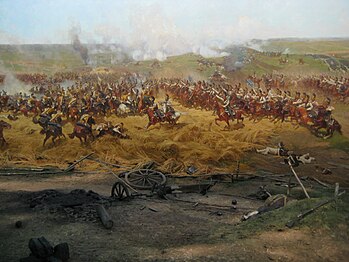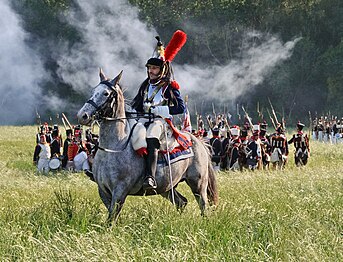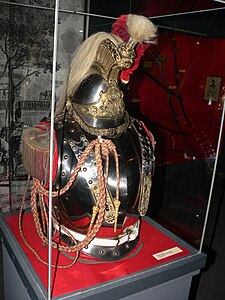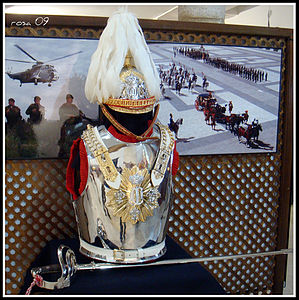
Cuirassier
Cuirassiers (/ˌkwɪrəˈsɪər/; from French cuirassier[1] [kɥiʁasje]) were cavalry equipped with a cuirass, sword, and pistols. Cuirassiers first appeared in mid-to-late 16th century Europe as a result of armoured cavalry, such as men-at-arms and demi-lancers discarding their lances and adopting pistols as their primary weapon.[2] In the later part of the 17th century, the cuirassier lost his limb armour and subsequently wore only the cuirass (breastplate and backplate), and sometimes a helmet. By this time, the sword or sabre had become his primary weapon, with pistols relegated to a secondary function.
Cuirassiers achieved increased prominence during the Napoleonic Wars and were last fielded in the opening stages of World War I (1914–1918). A number of countries continue to use cuirassiers as ceremonial troops.
The French term cuirassier means "one with a cuirass" (French: cuirasse), the breastplate armour which they wore.[3]
Body armour, was restricted to a cuirass, which fell in and out of use during the 18th century; for example British cavalry entered the War of the Spanish Succession without body armour, although they readopted it during the conflict. Cuirassiers played a prominent role in the armies of Austria, and of Frederick the Great of Prussia. By the time of the French Revolutionary Wars, few heavy cavalry regiments, except those of Austria, wore the cuirass on campaign. The twelve Austrian cuirassier regiments in existence between 1768 and 1802 (when the number was reduced) unusually wore only a front plate.[12] This reduced the burden of the weight carried by the individual trooper, but left his back unprotected during a swirling cavalry melee.
Most heavy cavalry from c. 1700 to c. 1785 wore the tricorne hat, which evolved into the bicorne, or cocked hat, towards the close of the century. In the first two decades of the 19th century, helmets, often of hardened leather with brass reinforcement (though the French used iron-skulled helmets for their cuirassiers), replaced the bicorne hat.
A resurgence of armoured cavalry took place in France under the rule of Napoleon Bonaparte, who increased the number of armoured regiments from one to, ultimately, sixteen (fourteen cuirassier regiments plus two Carabiniers-à-Cheval regiments).
During the first few decades of the 19th century most of the major states of Europe, except Austria which had retained its armoured cavalry, readopted the cuirass for some of their heavy cavalry in emulation of the French. The Russians fielded two divisions of armoured cavalry, but most other states armoured a few senior regiments: Prussia three regiments, the Kingdom of Saxony three, the Kingdom of Westphalia two, Spain one (Coraceros Españoles) and the Duchy of Warsaw one. The three Household Cavalry regiments of the British Army (1st and 2nd Life Guards and Royal Horse Guards) adopted cuirasses shortly after the Napoleonic Wars as a part of their full dress uniforms, but never had occasion to wear the armour in battle.. However as late as 1887 these regiments were still wearing cuirasses on maneuvers in "field day order".[13]
Cuirassiers were generally the senior branch of the mounted portion of an army, retaining their status as heavy cavalry—"big men on big horses". Their value as a heavy striking force during the Napoleonic Wars ensured that the French, Russian, and Prussian armies continued to use cuirassier regiments throughout the 19th century. The Austrian cuirassiers were abolished in 1868.[14]
For the reasons of both climate and cost, cuirassiers of the 19th century type seldom appeared outside of Europe and Latin America . However Ranjit Singh's Sikh Army (the Khalsa) of the 1830s included two regiments of cuirassiers equipped and armed in French fashion. Four hundred carabinier cuirasses were imported from France while helmets and uniforms were manufactured in Wazirabad.[15]
The development of firearms, which reduced the effectiveness of expensive heavy armour, led to a considerable reduction of the size and complexity of the latter. This form of protection was reduced in the latter half of the 17th century to the breastplate and the helmet, both of which eventually became largely decorative against projectiles but still retained their effectiveness against swords, lances, bayonets, and other edged weapons.









